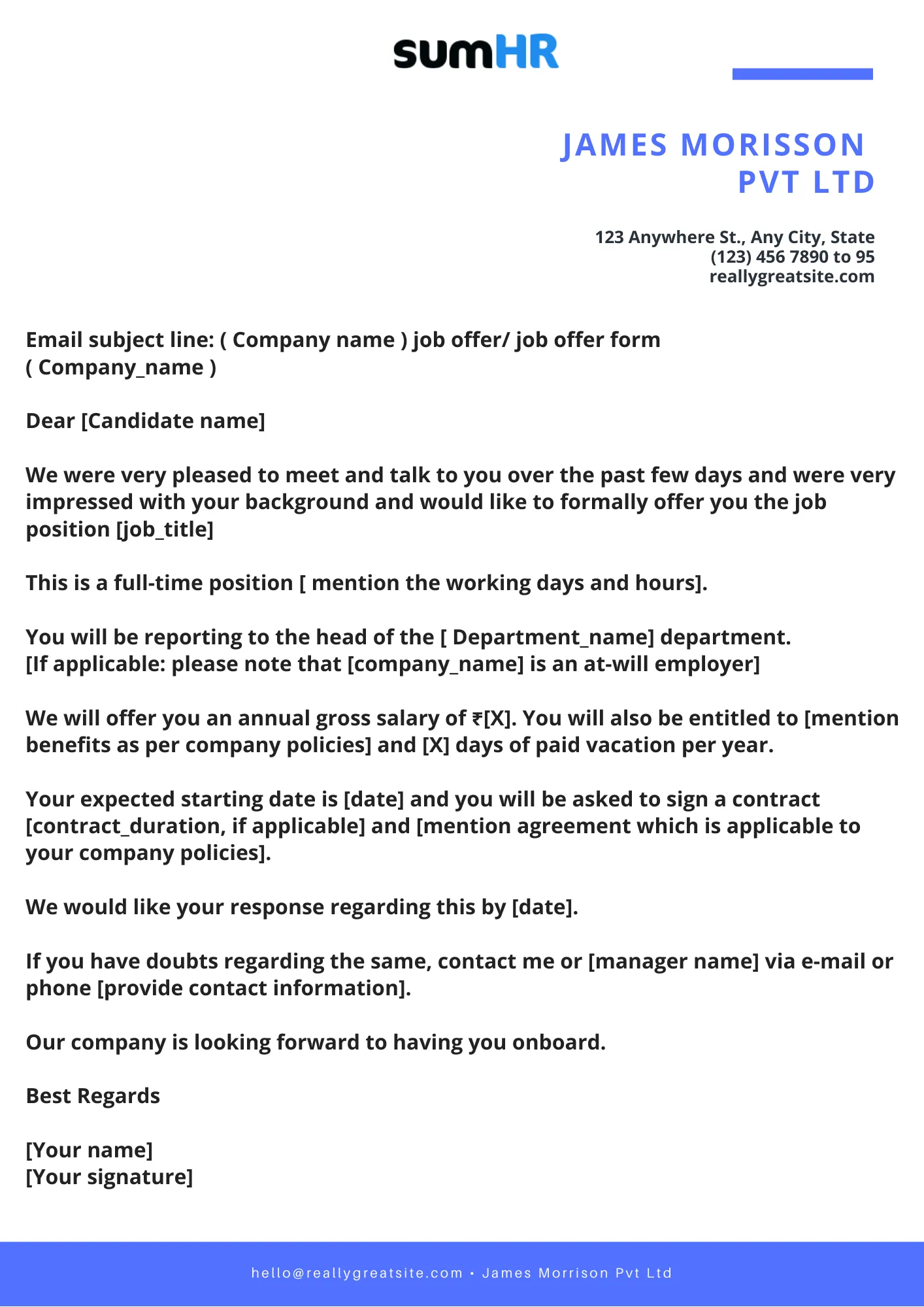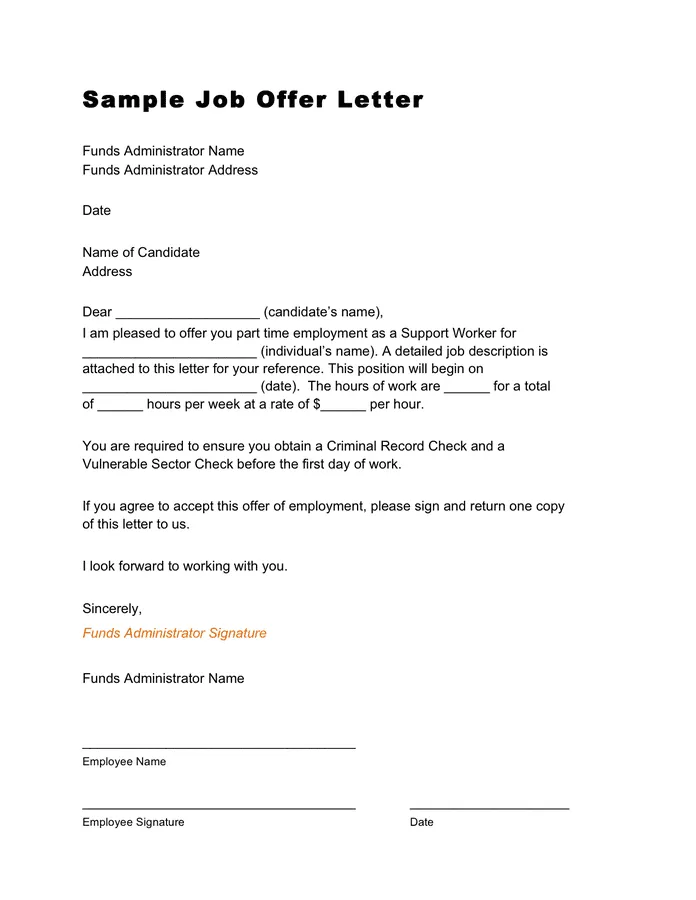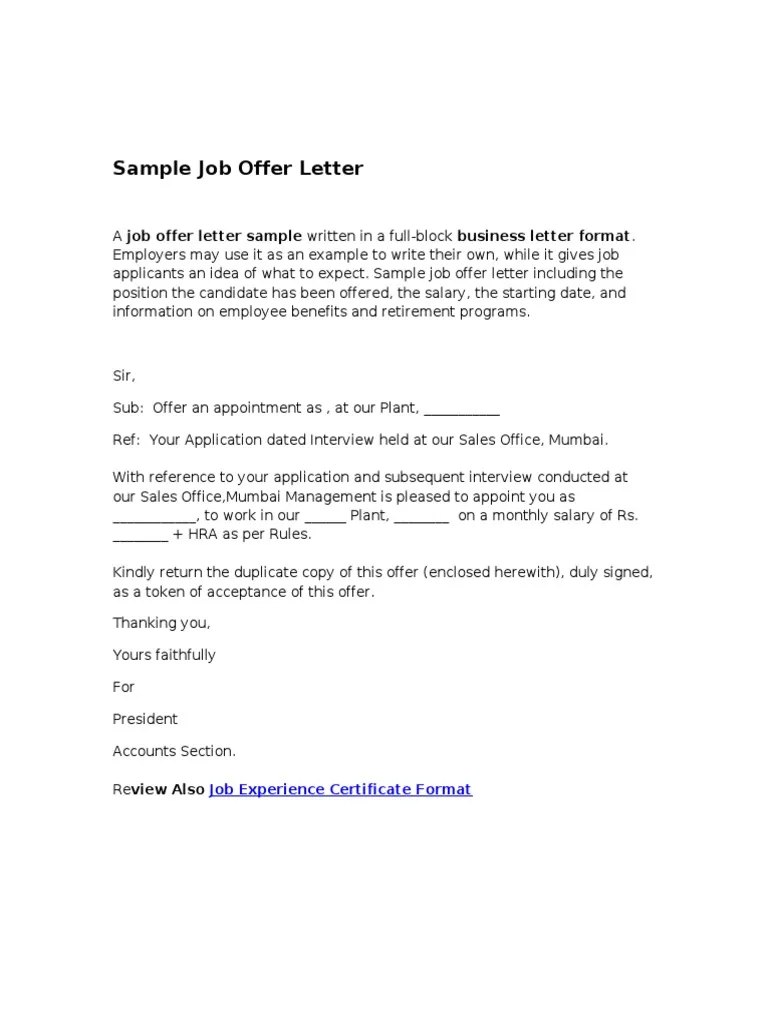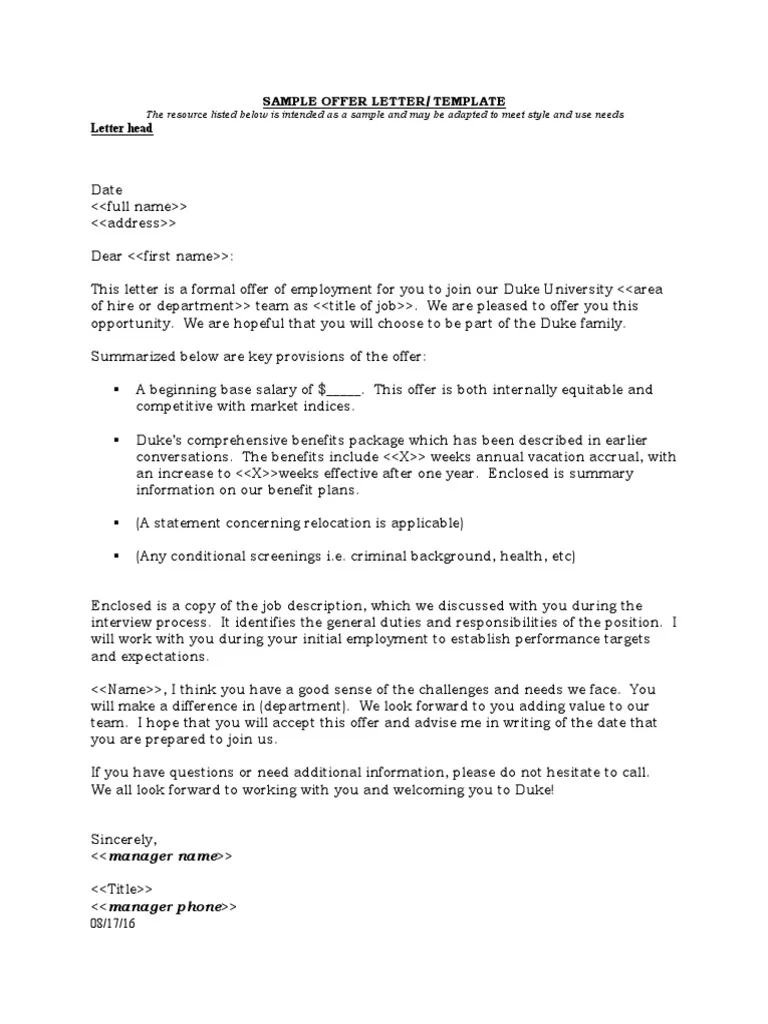Understanding the Job Offer Cover Letter
A job offer cover letter is a crucial document that accompanies your resume when applying for a job. It serves as your personal introduction to the hiring manager, allowing you to highlight your skills, experience, and personality in a way that a resume alone cannot. It’s your chance to make a strong first impression and demonstrate why you are the ideal candidate for the position. Unlike a resume, which provides a factual overview of your career, a cover letter enables you to connect with the employer on a more personal level. It shows that you’ve taken the time to understand the company and the role, and that you’re genuinely enthusiastic about the opportunity. A well-crafted cover letter can significantly increase your chances of getting an interview, so investing time and effort into creating a compelling one is essential. Remember, it’s not just a formality; it’s a strategic tool in your job search arsenal. Also, remember to highlight your soft skills and how your work ethics aligns with the company values.
Why Is a Job Offer Cover Letter Important?
The importance of a job offer cover letter cannot be overstated. It’s often the first thing a hiring manager sees, and it sets the tone for your application. It provides an opportunity to expand on the information in your resume and to tailor your qualifications to the specific requirements of the job. A well-written cover letter demonstrates your communication skills, your attention to detail, and your genuine interest in the position and the company. It allows you to address any potential gaps in your resume, such as career changes or periods of unemployment, and to explain how your skills and experience make you a strong fit for the role. Furthermore, a cover letter can help you differentiate yourself from other applicants by showcasing your unique personality and what you can bring to the team. The cover letter also enables you to address any questions that might come up in the interview process and to prove that you pay attention to detail by following all of the job offer instructions.
Highlighting Your Skills and Experience

When highlighting your skills and experience in a job offer cover letter, be strategic and specific. Don’t just list your skills; provide concrete examples of how you’ve used those skills to achieve results. Use the job description as your guide, and identify the key skills and qualifications the employer is seeking. Then, provide examples from your past experiences that demonstrate how you’ve successfully applied those skills. Quantify your achievements whenever possible, using numbers and data to show the impact you’ve made in previous roles. For instance, instead of saying “Managed social media campaigns”, say “Managed social media campaigns, increasing follower engagement by 30% and website traffic by 20% within six months”. This approach makes your accomplishments more compelling and demonstrates your ability to deliver results. Tailor your examples to match the specific requirements of the job, showing the employer that you understand what the role entails and that you have the skills needed to excel. Always focus on the value you can bring to the company and emphasize the benefits of hiring you.
Matching Your Skills With Job Requirements
Matching your skills with the job requirements is crucial for creating an effective job offer cover letter. Begin by carefully reviewing the job description, identifying the key skills, qualifications, and experiences the employer is seeking. Next, assess your own skills and experiences and identify those that align with the job requirements. Focus on the most relevant skills and experiences, and provide specific examples of how you’ve demonstrated those skills in the past. Use keywords from the job description throughout your cover letter, but be careful not to overdo it. Integrate the keywords naturally into your sentences to show that you understand the role and that you have the qualifications needed to succeed. In your cover letter, explain how your skills and experience will benefit the company and contribute to its goals. Show the employer that you’ve done your research and that you understand the company’s mission, values, and culture. By clearly demonstrating how your skills and experience align with the job requirements, you’ll increase your chances of getting an interview. Make sure to pay attention to the language and the way the job is described, and always be honest.
How to Tailor Your Cover Letter for a Specific Role
Tailoring your cover letter for a specific role is essential for making a strong impression on the hiring manager. Start by thoroughly researching the company and the specific job you’re applying for. Understand the company’s mission, values, and culture, and identify the key requirements of the role. Then, use this information to customize your cover letter to match the specific needs of the employer. Address the hiring manager by name if possible, and express your genuine interest in the company and the role. Highlight the skills and experiences that are most relevant to the job requirements, providing specific examples of your accomplishments. Use keywords from the job description throughout your cover letter, but be careful not to overdo it. Show the employer that you understand the role and that you have the qualifications needed to succeed. Avoid using a generic cover letter template and instead, create a unique document that reflects your personality and your genuine enthusiasm for the opportunity. Take the time to proofread and edit your cover letter carefully to ensure it is free of errors and reflects your professionalism.
Formatting Your Cover Letter for Maximum Impact

Formatting your cover letter effectively can significantly impact the hiring manager. Choose a professional and easy-to-read font, such as Arial, Times New Roman, or Calibri, and use a font size between 10 and 12 points. Use single spacing and leave adequate margins (1 inch on all sides) to provide a clean and organized appearance. Keep your cover letter concise, ideally no more than one page. Use clear headings and bullet points to break up large blocks of text and make it easy for the hiring manager to scan the document. Ensure your cover letter is well-structured, with a clear opening, body, and closing. In the opening, state the position you’re applying for and express your interest in the opportunity. In the body, highlight your relevant skills and experiences, providing specific examples of your accomplishments. In the closing, express your enthusiasm for the role and reiterate your interest in an interview. Proofread your cover letter carefully for any errors in grammar, spelling, and punctuation. A well-formatted cover letter demonstrates your attention to detail and professionalism, making a positive impression on the hiring manager. Also, make sure to address your cover letter to the correct person.
Key Elements of a Job Offer Cover Letter
A compelling job offer cover letter includes several key elements that work together to showcase your qualifications and enthusiasm. It should start with a professional heading, including your contact information and the date, followed by the hiring manager’s name and the company’s address. The opening paragraph should immediately state the position you are applying for and how you learned about the opportunity. The body paragraphs should then highlight your relevant skills and experiences, providing specific examples of your accomplishments. Use action verbs to describe your accomplishments and quantify your achievements whenever possible. Also, demonstrate your understanding of the company’s needs and how you can contribute to their success. In the closing paragraph, express your enthusiasm for the role and reiterate your interest in an interview. Thank the hiring manager for their time and consideration and provide your contact information. Make sure to proofread your cover letter carefully for any errors in grammar, spelling, and punctuation.
1 Opening Captivating the Reader
The opening paragraph of your job offer cover letter is critical as it sets the tone for the rest of your document. It should immediately grab the reader’s attention and make them want to learn more about you. Start by addressing the hiring manager by name if possible, and state the position you’re applying for. Then, express your enthusiasm for the opportunity and briefly explain why you are interested in the role. You might mention how you learned about the position, such as through a company website, job board, or referral. Avoid generic opening statements and instead, personalize your introduction to make it more engaging. You can also include a brief statement about your key skills or experiences that align with the job requirements. For example, you could say, “I am writing to express my interest in the Marketing Manager position, as advertised on LinkedIn. With my five years of experience in digital marketing and my proven track record of increasing website traffic by over 40%, I am confident I can make a significant contribution to your team.” Keep it concise, enthusiastic, and focused on the value you can bring to the company.
2 Body Paragraphs Showcasing Your Value

The body paragraphs are the heart of your job offer cover letter, where you showcase your value to the employer. Focus on highlighting the skills, experiences, and accomplishments that are most relevant to the job requirements. Use specific examples from your past to demonstrate how you’ve successfully applied those skills in previous roles. Start each paragraph with a clear topic sentence that introduces the main idea, then provide supporting details and evidence to back it up. Quantify your achievements whenever possible, using numbers and data to show the impact you’ve made. Use action verbs to describe your accomplishments and emphasize the results you achieved. Tailor your examples to match the specific needs of the job, showing the employer that you understand what the role entails and that you have the skills needed to excel. Connect your skills and experiences to the company’s goals and objectives. Make sure to explain how your skills will benefit the company and contribute to its success. Keep your paragraphs concise, focused, and easy to read, using clear language and avoiding jargon.
3 Closing Expressing Enthusiasm and Next Steps
The closing paragraph of your job offer cover letter is your final opportunity to make a positive impression. Begin by expressing your enthusiasm for the role and reiterating your interest in an interview. Reiterate your excitement about the opportunity and the company, and thank the hiring manager for their time and consideration. Clearly state your availability for an interview and provide your contact information. You can also briefly mention your availability for a follow-up call or email. Avoid generic closing statements and instead, personalize your message to make it more engaging. For example, you could say, “I am very excited about the opportunity to join your team and contribute my skills to [Company Name]. I am available for an interview at your earliest convenience and can be reached at [phone number] or [email address]. Thank you again for your time and consideration.” End with a professional closing, such as “Sincerely” or “Best regards”, followed by your full name. Ensure your closing is clear, concise, and reflects your professionalism.
Proofreading and Editing Your Cover Letter
Proofreading and editing your job offer cover letter is essential for ensuring it is free of errors and presents you in the best possible light. After you’ve written your cover letter, take the time to carefully review it for any mistakes in grammar, spelling, punctuation, and formatting. Read your cover letter aloud to catch any awkward phrasing or unclear sentences. Use a grammar checker to identify any errors you may have missed. Pay close attention to the details, such as the correct spelling of the hiring manager’s name and the company’s address. Ask a friend, family member, or career advisor to proofread your cover letter. They can provide a fresh perspective and catch any errors you may have missed. Ensure your cover letter is concise and easy to read, with clear headings and bullet points to break up large blocks of text. A polished and error-free cover letter demonstrates your attention to detail and professionalism, making a positive impression on the hiring manager. Do not submit your cover letter before proofreading it.
Common Mistakes to Avoid in Your Cover Letter

Avoid common mistakes in your job offer cover letter to make a strong impression on the hiring manager. Do not use a generic template; customize your cover letter for each job you apply for. Avoid simply repeating your resume; expand on your skills and experiences and provide specific examples of your accomplishments. Do not make spelling and grammatical errors; proofread your cover letter carefully before submitting it. Avoid being too casual or informal in your tone; maintain a professional and respectful demeanor. Do not write too much or too little; keep your cover letter concise and focused on the most relevant information. Avoid using clichés or buzzwords; use clear and concise language to communicate your message. Do not focus solely on what you want; emphasize what you can offer the company and how you can contribute to its success. Avoid exaggerating or lying about your skills or experiences; be honest and transparent in your application. Finally, do not submit a cover letter without including your contact information.
Formatting and Presentation Tips
Formatting and presentation play a crucial role in making your job offer cover letter stand out. Choose a professional font such as Arial, Times New Roman, or Calibri in a readable size, typically 10-12 points. Use a clean and simple layout with adequate margins (1 inch on all sides) to avoid a cluttered appearance. Ensure consistent spacing throughout your cover letter, using single spacing within paragraphs and double spacing between paragraphs. Use clear headings and bullet points to break up large blocks of text and make it easier for the reader to scan the document. Use bolding or italics sparingly to highlight key information and avoid overuse. Tailor your formatting to the company’s brand guidelines if possible, but always prioritize readability and professionalism. Save your cover letter as a PDF to ensure that the formatting remains consistent across different devices. Use a professional-looking email signature that includes your name, contact information, and a link to your LinkedIn profile.
Conclusion Crafting a Compelling Job Offer Cover Letter
Crafting a compelling job offer cover letter is a key step in your job search journey. By understanding its importance, highlighting your skills and experience, matching your qualifications with job requirements, and tailoring your letter to each specific role, you significantly increase your chances of success. Remember to focus on the key elements, including an engaging opening, compelling body paragraphs, and a strong closing. Proofread and edit your cover letter meticulously to eliminate any errors and avoid common pitfalls. Pay attention to formatting and presentation to ensure your letter looks professional and polished. By following these tips, you can create a job offer cover letter that showcases your unique value, grabs the hiring manager’s attention, and increases your chances of landing an interview. Invest the time and effort to craft a well-written cover letter, and you’ll be well on your way to securing your dream job. Good luck with your job search!
